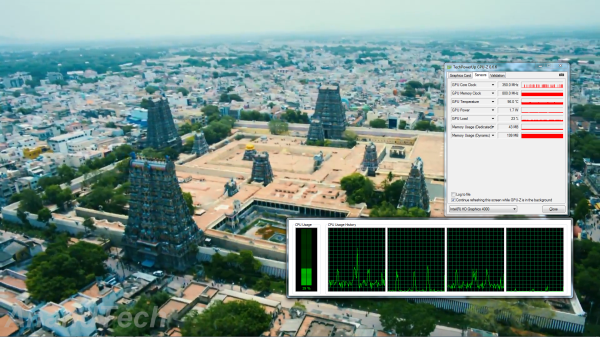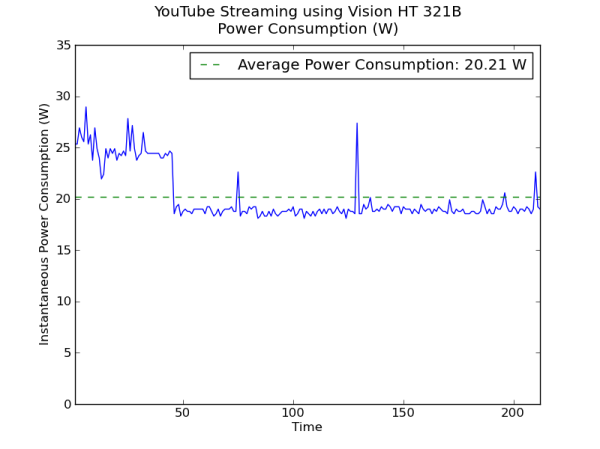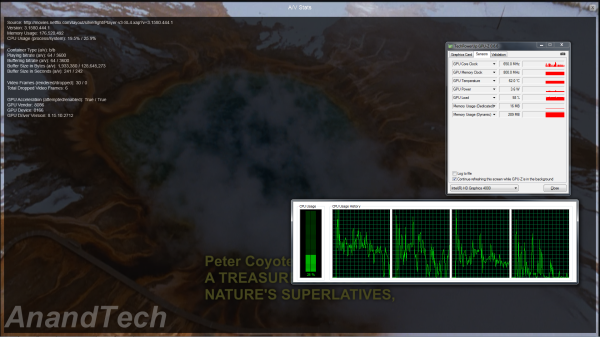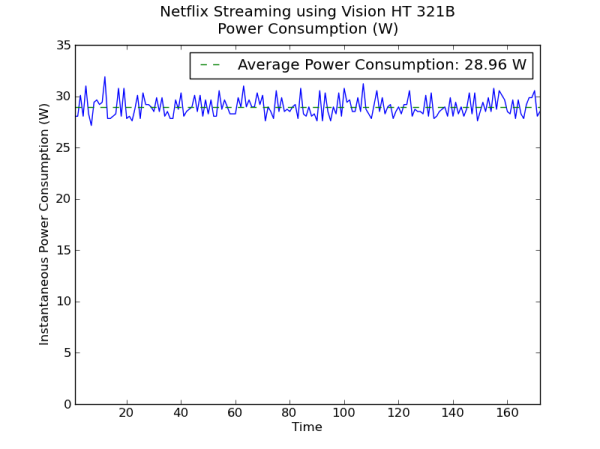ASRock Vision HT: Ivy Bridge Carries the SFF HTPC Forward
by Ganesh T S on November 12, 2012 3:30 PM EST- Posted in
- Home Theater
- ASRock
- HTPC
- Ivy Bridge
Networking Performance and Streaming Aspects
In this section, we will take a look at the networking capabilities of the unit and also our standard HTPC streaming tests (involving YouTube and Netflix). ASRock delivered dual-band Wi-Fi in the Vision HT 321B. The 5 GHz band is able to practically deliver more than double the throughput of the 2.4 GHz band when used with an appropriate router.
Dual Band Wi-Fi
We used Ixia's IxChariot to check the TCP throughput in the 2.4 and 5 GHz bands using Western Digital's MyNet N900 router with default settings. We tested at two locations, one right next to the router and the other across a wall, separated by around 30 ft. The gallery below shows the throughput graphs obtained. While the 2.4 GHz band is able to deliver around 65 Mbps real-world throughput, the 5 GHz band delivers around 160 Mbps.
Under these circumstances, it becomes possible to even stream uncompressed Blu-ray rips over the wireless network. Unlike 2.4 GHz, the 5 GHz band is not prone to interference. However, the range is smaller.
YouTube and Netflix Streaming
The drivers for the Intel HD 4000 enable hardware accelerated decode and rendering for both YouTube and Netflix streams in Flash and Silverlight respectively. Screenshots of our standard test streams in action are provided below. In addition, we are also providing power consumption graphs over time for the full YouTube clip and a segment of the Netflix clip.
Adobe Flash Hardware Acceleration (YouTube)
The power consumption graph for the YouTube clip above shows that the unit consumes more power in the beginning as the video is streamed over the Wi-Fi network, but, later, settles down to a lower value corresponding to the decode and rendering steps.
Hardware Acceleration for Netflix in Microsoft Silverlight
Unlike YouTube, Netflix doesn't seem to buffer the full movie during playback on a PC. After filling up a pre-determined buffer size, the download rate seems to throttle down to maintain it. The power consumption graph shows the unit's characteristics during playback with simultaneous download over Wi-Fi.


















40 Comments
View All Comments
Guspaz - Monday, November 12, 2012 - link
The lack of DisplayPort video output is kind of a big deal... DisplayPort is the only output that the Intel HD 4000 supports high resolution (like 2560x1440 or 2560x1600) over. It will not output these resolutions over HDMI or DVI, as the Intel HD 4000 does not support dual-link DVI.As this is a rather severe shortcoming to a user with a 27" or larger monitor, and users may expect support for this resolution since the chip itself does support it, it should be mentioned in the review. Otherwise, a user might buy this computer only to find out that it doesn't support any 27" monitors...
A better approach would have been for Asrock to include a DisplayPort instead of DVI, and then include a cheap passive DP->DVI adapter in the box. Such adapters are very cheap (under $7 from monoprice), so this would have been an enormously more flexible option.
As the system stands, with no option for a videocard slot, this system can never support large displays.
hughlle - Monday, November 12, 2012 - link
The vast majority of users will be using an HTPC with their HDTV, not a "small" high end moniter, so for the majority of users wanting an HTPC, 1920x1080, as in HD resolutions, is what they will be looking for.methudman6 - Monday, November 12, 2012 - link
It could've been marketed as a "PC-Mini" too if it had display port. I find it strange that they market it so strongly as an HTPC when it looks like it'd make a very nice small computer for casual use.Guspaz - Tuesday, November 13, 2012 - link
There is nothing about this system that makes it an "HTPC" except the cheap remote they include with it, and that's something you can add to any computer for a few dollars. It's just as well suited as a general SFF computer except for this issue. Previous Asrock systems in this identical form factor (and I've used a few of the ION ones for media playback at a large convention) didn't even have a remote.Death666Angel - Tuesday, November 13, 2012 - link
But it also seems like an oversight for Intel to not have DVI 2560 output. What did they gain by that omission?Guspaz - Tuesday, November 13, 2012 - link
Pin count, perhaps? Take a look at the respective pin counts, and I'll exclude hotplug, power, shield, ground, reserved, analog (except on VGA), or optional pins, since none of those would have to be routed to the CPU AFAIK.:DVI: 10 pins
DisplayPort: 10 pins
HDMI: 11 pins
VGA: 12 pins
DVI Dual-Link: 16 pins
I may be excluding some pins that do in fact have to be routed to the CPU, but my basic point is that adding dual-link DVI support would have required adding more pins/traces to the processor, socket, motherboard, etc. That's a non-trivial thing, and from Intel's perspective you can use an adapter to get dual-link DVI anyhow (although at $69 from monoprice, the adapter isn't cheap like the $8 single-link DVI adapter is)
deadlockedworld - Monday, November 12, 2012 - link
Apple should sue!! (seriously though, the shape is almost exactly the same as the previous generation mini)Guspaz - Tuesday, November 13, 2012 - link
The Asrock machines are waaay bigger than the Mini, and the Mini wasn't the first to use that form factor (mini ITX boxes predate it). It was the thinnest of them, to be sure, but not the first.IlllI - Monday, November 12, 2012 - link
wonder what ever happened to those. looks like they dont sell them anymoreGrok42 - Monday, November 12, 2012 - link
I cut the cord/dish 6 years ago. My kids have all grown up not having access to normal television programming. I have a WD-Live x2, Roku x3, iPodses, iPads and iPhones all which can basically access the same media including a 6TB NAS drive. I rip all the kids movies to the NAS drive as soon as we buy them which is 90% of what is on the NAS drive other than home movies and photos. I watch movies from NetFlix, Hulu or rent them on Amazon. I love browsing YouTube from the WD-Live for most of the misc stuff.What else does a HTPC bring to the table that the ~$99 WD-Live doesn't do better and for less? The WD-Live is tiny, has no fans and is Velcroed to the back of my entertainment system. It is plugged into a Wireless N router and can stream 1080P movies with ease. The only thing I can think of is that I can't play PC games or Surf; is there something else?
Not a troll, I sort of feel like I'm making this huge mistake not having an HTPC given my setup but I can never figure out why I would want one.